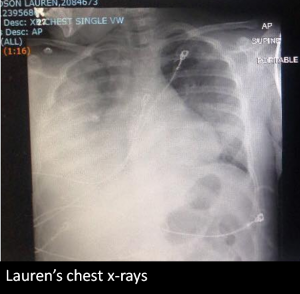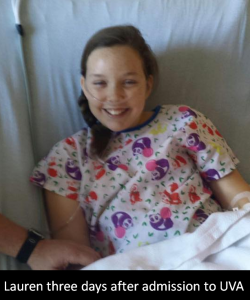If you had a  conversation with Lauren Davidson you would think she is your typical 12 year-old girl. Her striking blue eyes, love for animals and bright personality are a few of the many qualities that make Lauren so special. Upon meeting Lauren, what you wouldn’t know is she suffers from Granulomatosis with Polyangiitis (GPA), also known as Wegener’s Granulomatosis, a rare autoimmune disease that causes inflammation of the blood vessels in organs like the kidneys or lungs – making it difficult to breathe. The cause of GPA is unknown, and if left untreated can be fatal within months. Lauren’s battle with GPA is one that will never truly be over, as there is no cure but rather treatment options for symptoms. Her strength, bravery and positivity allow her to fight this incurable disease that many of us have never heard of, until now.
conversation with Lauren Davidson you would think she is your typical 12 year-old girl. Her striking blue eyes, love for animals and bright personality are a few of the many qualities that make Lauren so special. Upon meeting Lauren, what you wouldn’t know is she suffers from Granulomatosis with Polyangiitis (GPA), also known as Wegener’s Granulomatosis, a rare autoimmune disease that causes inflammation of the blood vessels in organs like the kidneys or lungs – making it difficult to breathe. The cause of GPA is unknown, and if left untreated can be fatal within months. Lauren’s battle with GPA is one that will never truly be over, as there is no cure but rather treatment options for symptoms. Her strength, bravery and positivity allow her to fight this incurable disease that many of us have never heard of, until now.
GPA is classified as a rare or orphan disease, which is defined as an illness that affects less than 200,000 people in the United States. According to The Jackson Laboratory, there are over 7,000 orphan diseases, affecting a startling 350 million people worldwide. Ninety percent of orphan diseases do not have a cure.
Lauren started having symptoms of GPA in June 2015, a week after her 11th birthday. She complained of joint pain in all areas of her body. “One day it would be her hip, the next her knee, then her ankle,” Susan Davidson, Lauren’s mom, said. One day Susan gave Lauren crutches because she could hardly walk – the next day she was fine. Lauren swam competitively and had to leave practice early on several occasions because she felt like she couldn’t breathe; and on October 13, 2015 every parent’s worst nightmare began.
 Susan heard Lauren call her name from upstairs and found her daughter crouched over, coughing up a pool of blood and unable to stand. Lauren had other symptoms of a high fever and loss of appetite, and Susan thought it was a virus from a previous doctor’s visit. Susan immediately took Lauren to the doctor as Lauren faded in and out of consciousness. The pediatrician knew something serious was wrong and had Lauren rushed to the hospital, and ultimately ended up at the University of Virginia (UVA) Children’s Hospital with oxygen levels in the 80’s, hemoglobin of 5.3, and worrisome chest x-rays.
Susan heard Lauren call her name from upstairs and found her daughter crouched over, coughing up a pool of blood and unable to stand. Lauren had other symptoms of a high fever and loss of appetite, and Susan thought it was a virus from a previous doctor’s visit. Susan immediately took Lauren to the doctor as Lauren faded in and out of consciousness. The pediatrician knew something serious was wrong and had Lauren rushed to the hospital, and ultimately ended up at the University of Virginia (UVA) Children’s Hospital with oxygen levels in the 80’s, hemoglobin of 5.3, and worrisome chest x-rays.
Within 12 hours of admission to UVA, Lauren was diagnosed with GPA. For many, it takes one to five years to get a proper diagnosis. Lauren’s quick diagnosis upon arriving at UVA may have saved her life, and proves the importance of continued advancement in the area of orphan disease research and treatment development.
Lauren underwent two blood transfusions, chemotherapy infusions, and two infusions of the biological drug Rituxan – each of which cost $48,000. Although Lauren attempts to lead as normal of a life as possible, things have changed since her diagnosis. “[Lauren] sees a rheumatologist monthly, a nephrologists every three months, and a pulmonologist and an ENT once a year. She has blood drawn and urine tests every month at UVA,” Susan explained. “How has it affected her life? I like the way her nephrologists explained it. She said to Lauren, ‘You have a tiger living inside of you. Your tiger is either in the cage or out of the cage.’ Lauren lives with a constant awareness that there is something living inside of her that could be unleashed any moment. However, now that we know what she has, we’re hoping the worst is behind us.”
While Laur en’s story is filled with hardship, there is hope as increased attention and funding is dedicated towards orphan diseases. Recently, the NIH awarded 55 million dollars towards personalized medicine projects. According to Genetic Engineering and Biotechnology News, “NIH said the $55 million will support four projects, including a Data and Research Support Center designed to acquire, organize, and provide secure access to what the agency said will be one of the world’s largest and most diverse datasets for precision medicine research.”
en’s story is filled with hardship, there is hope as increased attention and funding is dedicated towards orphan diseases. Recently, the NIH awarded 55 million dollars towards personalized medicine projects. According to Genetic Engineering and Biotechnology News, “NIH said the $55 million will support four projects, including a Data and Research Support Center designed to acquire, organize, and provide secure access to what the agency said will be one of the world’s largest and most diverse datasets for precision medicine research.”
The world of personalized medicine has evolved over the years, and rather than a “one-size-fits-all” approach for treatment, patients’ needs are treated based on lifestyle, genetics, environment and other factors. Innovative researchers from the Virginia Tech Carilion Research Institute are merging industry and academia to bring deeper understanding and more effective treatments for those with orphan diseases.
Lauren’s doctors will continue to monitor her for the rest of her life. She is on a variety of medications to keep the GPA “tiger” in its cage—so she can enjoy as normal of a life as possible. Stories like Lauren’s are a sobering reminder of why scientists, researchers, and doctors must stay motivated to better understand orphan diseases and develop effective treatments.
